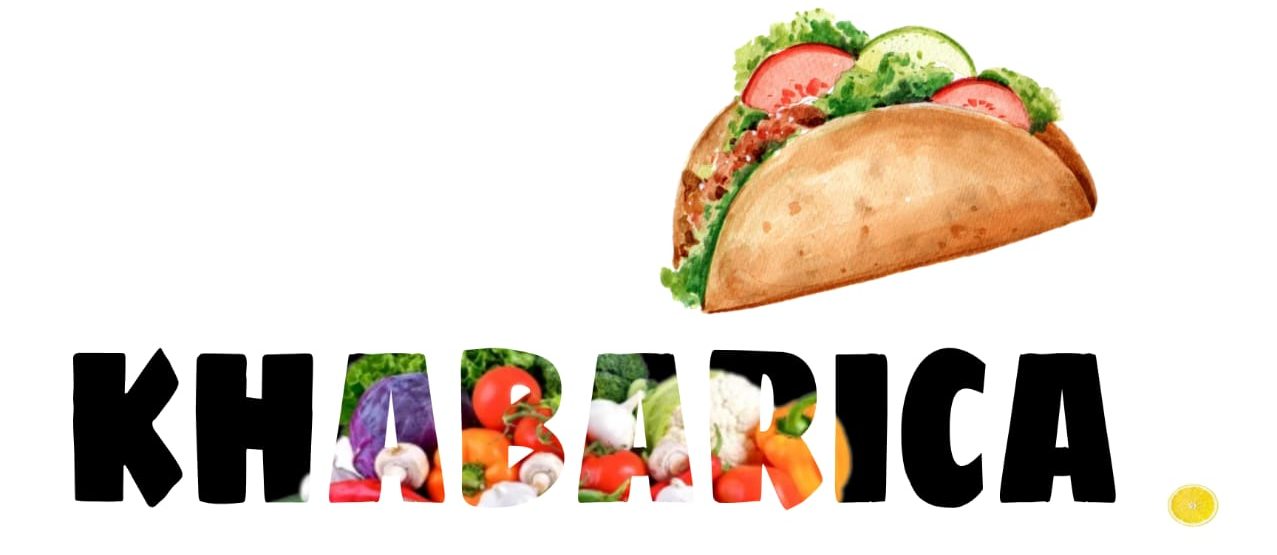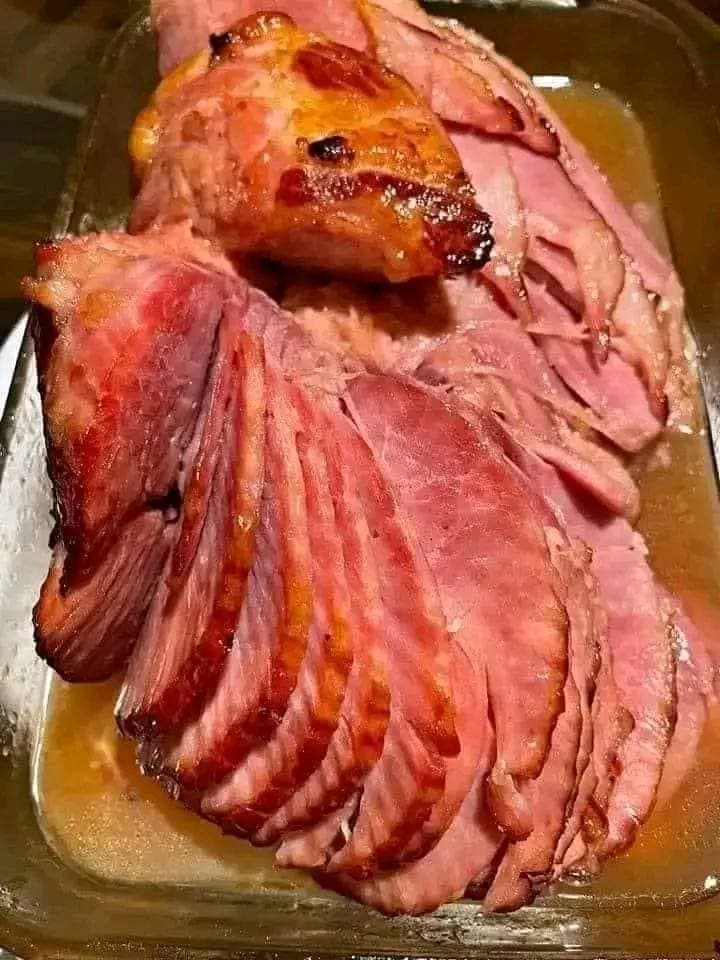- 1 bone-in ham (8-10 pounds)
- 1 cup water
For the Glaze:
- 1 cup honey
- 1/2 cup brown sugar
- 1/4 cup Dijon mustard
- 2 tablespoons apple cider vinegar
- 1 teaspoon ground cloves
- 1/2 teaspoon ground cinnamon
Instructions:
Step 1: Prepare the Ham
- Preheat your oven to 325°F (163°C).
- Place the ham in a roasting pan, fat side up. Add 1 cup of water to the bottom of the pan. Cover the pan with aluminum foil.
Step 2: Bake the Ham
- Bake the ham in the preheated oven for about 15-18 minutes per pound or until it reaches an internal temperature of 140°F (60°C). This should take around 2.5 to 3 hours for an 8-10-pound ham.
Step 3: Prepare the Glaze
- While the ham is baking, prepare the glaze. In a saucepan, combine honey, brown sugar, Dijon mustard, apple cider vinegar, ground cloves, and ground cinnamon.
- Heat the glaze over medium heat, stirring constantly until the sugar has dissolved and the mixture has thickened slightly. This usually takes about 5-7 minutes. Remove it from the heat.
Step 4: Glaze the Ham
- About 20-30 minutes before the ham is done, remove it from the oven. Increase the oven temperature to 400°F (204°C).
- Carefully uncover the ham and brush a generous amount of the prepared glaze all over the ham.
- Return the ham to the oven and bake for an additional 20-30 minutes or until the glaze is caramelized, and the ham has a beautiful golden-brown color.
Step 5: Rest and Serve
- Remove the honey baked ham from the oven and let it rest for about 15-20 minutes before carving. This allows the juices to redistribute, ensuring a moist and flavorful ham.
- Carve the ham and serve it with any remaining glaze on the side.
Tips and Variations:
- Score the Ham: Before baking, you can score the ham by making shallow cuts in a diamond pattern on the fat. This helps the glaze penetrate and adds an attractive presentation.
- Pineapple and Cherries: For a classic touch, you can stud the ham with pineapple rings and maraschino cherries during the last 20 minutes of baking.
- Double Glazing: To intensify the flavor, you can apply a second layer of glaze after the initial glazing and continue baking until caramelized.
- Leftovers: Honey baked ham leftovers are incredibly versatile. Use them in sandwiches, omelets, soups, or casseroles.
Conclusion:
Honey baked ham is a timeless dish that brings warmth and flavor to your table. With a sweet and savory glaze, this recipe strikes the perfect balance of tradition and innovation. Whether you’re celebrating a holiday or simply indulging in a special meal, this ham is sure to delight your taste buds and create lasting memories.
Here’s a rough breakdown of the nutrition information for a typical serving of honey baked ham (approximately 3 ounces or 85 grams):
Calories: Approximately 120-150 calories per serving.
Protein: About 15-18 grams of protein per serving, primarily from the ham.
Total Fat: Typically 6-9 grams of total fat per serving, primarily from the ham.
Saturated Fat: Approximately 2-3 grams of saturated fat per serving, primarily from the ham.
Cholesterol: Around 35-45 milligrams of cholesterol per serving, primarily from the ham.
Carbohydrates: Minimal carbohydrates, usually less than 1 gram per serving, mainly from the glaze.
Dietary Fiber: Generally negligible dietary fiber in honey baked ham.
Sugars: The sugar content primarily comes from the glaze, and it can vary depending on the recipe. On average, it might be around 5-8 grams of sugar per serving.
Sodium: Ham is often cured and can be relatively high in sodium. A typical serving might contain 600-800 milligrams of sodium. However, the sodium content can vary widely based on the specific brand and preparation method.
Vitamins and Minerals: Honey baked ham provides essential nutrients such as protein, vitamin B12, zinc, and phosphorus, but the amounts are influenced by factors like the cut of ham and the glaze used.
Note: These nutritional values are approximate and can vary based on factors like the specific brand of ham, the type of glaze used, and portion sizes. It’s important to be mindful of portion control, especially if you’re watching your sodium intake. While honey baked ham can be a delicious addition to your meal, it’s also important to balance it with other nutritious foods and enjoy it in moderation.
The history of honey baked ham, also known as glazed ham, is closely linked to the traditions of curing and preserving meat. Here is a brief overview of the history of this culinary delight:
1. Ancient Preservation Techniques:
- The practice of preserving meat through salting and smoking dates back thousands of years to ancient civilizations. Early humans learned that by drying and salting meat, they could extend its shelf life, making it available for consumption during lean times.
2. European Origins:
- Honey glazed ham, as we know it today, likely has its roots in Europe. European culinary traditions have a rich history of using honey in various dishes, including those involving meat.
- In medieval Europe, the use of honey as a sweetener and glaze for roasted meats became more common, especially for special occasions and feasts.
3. Christmas Tradition:
- In England, roasted ham with a honey or sugar glaze became a popular dish for Christmas feasts during the Middle Ages and Renaissance periods. It was a festive centerpiece of holiday celebrations.
4. Colonial America:
- European immigrants brought their culinary traditions, including honey glazed ham, to the United States.
- In America, this dish evolved and became a part of traditional Southern cuisine. Ham, often smoked and glazed, played a significant role in Southern cooking.
5. Commercialization:
- The concept of honey baked ham became commercialized with the establishment of businesses specializing in selling pre-glazed and pre-cooked hams.
- One of the most well-known companies associated with honey baked ham in the United States is “HoneyBaked Ham,” founded in 1957 by Harry J. Hoenselaar. The company popularized the concept of spiral-sliced hams with a sweet glaze.
6. Holiday Tradition:
- Today, honey baked ham remains a beloved holiday tradition in many countries, especially during Easter and Christmas.
- While the preparation methods and glaze recipes may vary, the essence of a succulent, sweet-glazed ham remains a cherished part of festive meals.
In summary, honey baked ham has a rich history that traces its origins to preservation techniques, European culinary traditions, and holiday feasting. It has evolved over time and continues to be a centerpiece of special occasions and family gatherings, symbolizing warmth, celebration, and the joy of sharing a delicious meal.


